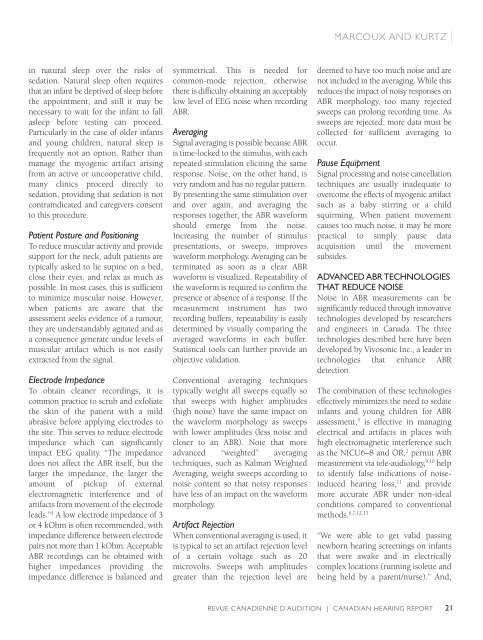Volume 8 Issue 3 (pdf) - Andrew John Publishing Inc
Volume 8 Issue 3 (pdf) - Andrew John Publishing Inc
Volume 8 Issue 3 (pdf) - Andrew John Publishing Inc
You also want an ePaper? Increase the reach of your titles
YUMPU automatically turns print PDFs into web optimized ePapers that Google loves.
|<br />
in natural sleep over the risks of<br />
sedation. Natural sleep often requires<br />
that an infant be deprived of sleep before<br />
the appointment, and still it may be<br />
necessary to wait for the infant to fall<br />
asleep before testing can proceed.<br />
Particularly in the case of older infants<br />
and young children, natural sleep is<br />
frequently not an option. Rather than<br />
manage the myogenic artifact arising<br />
from an active or uncooperative child,<br />
many clinics proceed directly to<br />
sedation, providing that sedation is not<br />
contraindicated and caregivers consent<br />
to this procedure.<br />
Patient Posture and Positioning<br />
To reduce muscular activity and provide<br />
support for the neck, adult patients are<br />
typically asked to lie supine on a bed,<br />
close their eyes, and relax as much as<br />
possible. In most cases, this is sufficient<br />
to minimize muscular noise. However,<br />
when patients are aware that the<br />
assessment seeks evidence of a tumour,<br />
they are understandably agitated and as<br />
a consequence generate undue levels of<br />
muscular artifact which is not easily<br />
extracted from the signal.<br />
Electrode Impedance<br />
To obtain cleaner recordings, it is<br />
common practice to scrub and exfoliate<br />
the skin of the patient with a mild<br />
abrasive before applying electrodes to<br />
the site. This serves to reduce electrode<br />
impedance which can significantly<br />
impact EEG quality. “The impedance<br />
does not affect the ABR itself, but the<br />
larger the impedance, the larger the<br />
amount of pickup of external<br />
electromagnetic interference and of<br />
artifacts from movement of the electrode<br />
leads.” 4 A low electrode impedance of 3<br />
or 4 kOhm is often recommended, with<br />
impedance difference between electrode<br />
pairs not more than 1 kOhm. Acceptable<br />
ABR recordings can be obtained with<br />
higher impedances providing the<br />
impedance difference is balanced and<br />
symmetrical. This is needed for<br />
common-mode rejection, otherwise<br />
there is difficulty obtaining an acceptably<br />
low level of EEG noise when recording<br />
ABR.<br />
Averaging<br />
Signal averaging is possible because ABR<br />
is time-locked to the stimulus, with each<br />
repeated stimulation eliciting the same<br />
response. Noise, on the other hand, is<br />
very random and has no regular pattern.<br />
By presenting the same stimulation over<br />
and over again, and averaging the<br />
responses together, the ABR waveform<br />
should emerge from the noise.<br />
<strong>Inc</strong>reasing the number of stimulus<br />
presentations, or sweeps, improves<br />
waveform morphology. Averaging can be<br />
terminated as soon as a clear ABR<br />
waveform is visualized. Repeatability of<br />
the waveform is required to confirm the<br />
presence or absence of a response. If the<br />
measurement instrument has two<br />
recording buffers, repeatability is easily<br />
determined by visually comparing the<br />
averaged waveforms in each buffer.<br />
Statistical tools can further provide an<br />
objective validation.<br />
Conventional averaging techniques<br />
typically weight all sweeps equally so<br />
that sweeps with higher amplitudes<br />
(high noise) have the same impact on<br />
the waveform morphology as sweeps<br />
with lower amplitudes (less noise and<br />
closer to an ABR). Note that more<br />
advanced “weighted” averaging<br />
techniques, such as Kalman Weighted<br />
Averaging, weight sweeps according to<br />
noise content so that noisy responses<br />
have less of an impact on the waveform<br />
morphology.<br />
Artifact Rejection<br />
When conventional averaging is used, it<br />
is typical to set an artifact rejection level<br />
of a certain voltage such as 20<br />
microvolts. Sweeps with amplitudes<br />
greater than the rejection level are<br />
deemed to have too much noise and are<br />
not included in the averaging. While this<br />
reduces the impact of noisy responses on<br />
ABR morphology, too many rejected<br />
sweeps can prolong recording time. As<br />
sweeps are rejected, more data must be<br />
collected for sufficient averaging to<br />
occur.<br />
Pause Equipment<br />
Signal processing and noise cancellation<br />
techniques are usually inadequate to<br />
overcome the effects of myogenic artifact<br />
such as a baby stirring or a child<br />
squirming. When patient movement<br />
causes too much noise, it may be more<br />
practical to simply pause data<br />
acquisition until the movement<br />
subsides.<br />
advanCed aBr teChnoLogies<br />
that reduCe noise<br />
Noise in ABR measurements can be<br />
significantly reduced through innovative<br />
technologies developed by researchers<br />
and engineers in Canada. The three<br />
technologies described here have been<br />
developed by Vivosonic <strong>Inc</strong>., a leader in<br />
technologies that enhance ABR<br />
detection.<br />
The combination of these technologies<br />
effectively minimizes the need to sedate<br />
infants and young children for ABR<br />
assessment, 5 is effective in managing<br />
electrical and artifacts in places with<br />
high electromagnetic interference such<br />
as the NICU6–8 and OR, 2 permit ABR<br />
measurement via tele-audiology, 9,10 help<br />
to identify false indications of noiseinduced<br />
hearing loss, 11 and provide<br />
more accurate ABR under non-ideal<br />
conditions compared to conventional<br />
methods. 6,7,12,13<br />
“We were able to get valid passing<br />
newborn hearing screenings on infants<br />
that were awake and in electrically<br />
complex locations (running isolette and<br />
being held by a parent/nurse).” And,<br />
REVUE CANADIENNE D’AUDITION | CANADIAN HEARING REPORT 21






